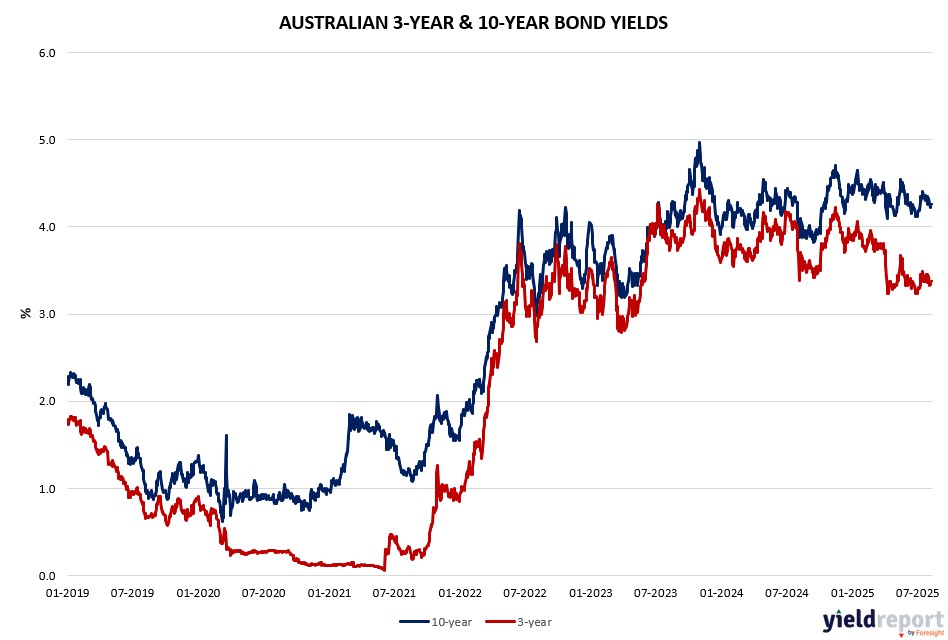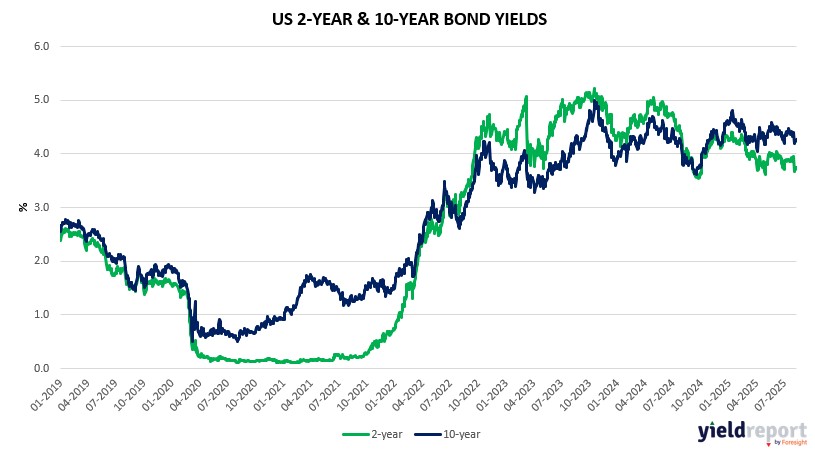| Close | Previous Close | Change | |
|---|---|---|---|
| Australian 3-year bond (%) | 3.372 | 3.377 | -0.005 |
| Australian 10-year bond (%) | 4.253 | 4.257 | -0.004 |
| Australian 30-year bond (%) | 4.965 | 4.976 | -0.011 |
| United States 2-year bond (%) | 3.75 | 3.742 | 0.008 |
| United States 10-year bond (%) | 4.266 | 4.254 | 0.012 |
| United States 30-year bond (%) | 4.8353 | 4.8273 | 0.008 |
Overview of the Australian Bond Market
Australian government bond yields rose on August 11, 2025, as robust commodity rallies and pre-RBA caution dominated, with the 10-year yield up 2 basis points to 4.26%, 2-year at 3.36% (+2 bp), 5-year at 3.66% (+1 bp), and 15-year at 4.61% (+1 bp). Monthly, yields dipped (10-year -7 bp), signaling easing inflation bets despite recent CPI stability.
June’s export surge (+6%) and import drop (-3.1%) bolstered trade data, heightening RBA cut speculation for Tuesday, pressuring bank margins but lifting resources. Global cues, including US-China truce extension talks and Fed’s 4.25%-4.5% hold, weigh in, with US 10-year at 4.27%. Australia’s July Services PMI at 54.1 and Composite at 53.8 affirm resilience, fostering a balanced bond outlook.
Traders track the US August 12 CPI (core 0.3% monthly expected) for Fed September cut clues (~60% for 25 bp). Locally, muted SPDR Australian Bond Fund moves indicate steady fixed-rate demand. With equity highs vulnerable to tariffs and growth dips, bonds serve as diversifiers, yet trade pacts and economic vigor may sustain elevated yields.

Overview of the US Bond Market
The yield on 10-year Treasuries was little changed at 4.28%. A dollar gauge rose 0.2%. Bitcoin briefly topped $122,000. Gold futures pared losses as Trump said gold imports will not face US tariffs.
The Fed’s two vice chairs, Michelle Bowman and Philip Jefferson, and Dallas Fed President Lorie Logan are under consideration to serve as chair of the central bank when the position opens next year, according to two administration officials. Treasury Secretary Scott Bessent will interview additional candidates in the coming weeks, said the officials.
Money markets show traders have priced in more than two rate reductions by December, with an about 80% probability of a quarter-point Fed cut as early as next month.
Meantime, interest-rate strategists at BofA lowered Treasury yield forecasts in anticipation that recent economic data will drive a shift in the Fed’s assessment of risks.
Strategists led by Mark Cabana cut their year-end forecast for two-year yields to 3.5%, from 3.75% previously. They see 10-year yields at 4.25% by the end of December compared with the previous estimate of 4.5%.
On the geopolitical front, President Trump downplayed expectations for his upcoming meeting with Russian leader Vladimir Putin as he seeks to end the war in Ukraine, casting it as a “feel-out meeting” and saying he would confer with Ukrainian and European leaders after the sitdown.
President Donald Trump is extending a tariff truce with China for another 90 days, stabilizing trade ties between the world’s two largest economies.


